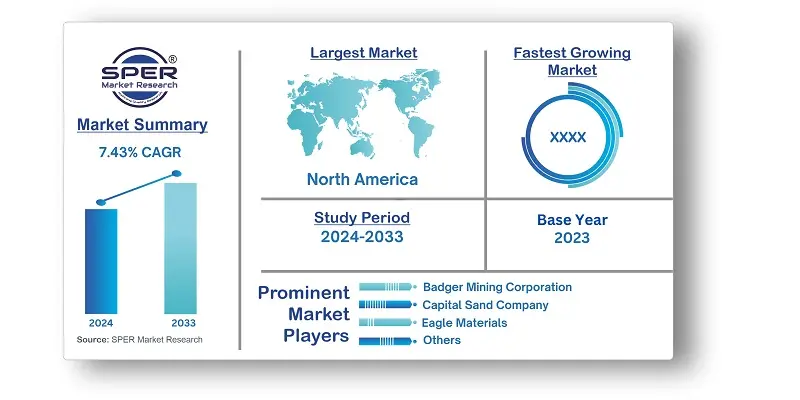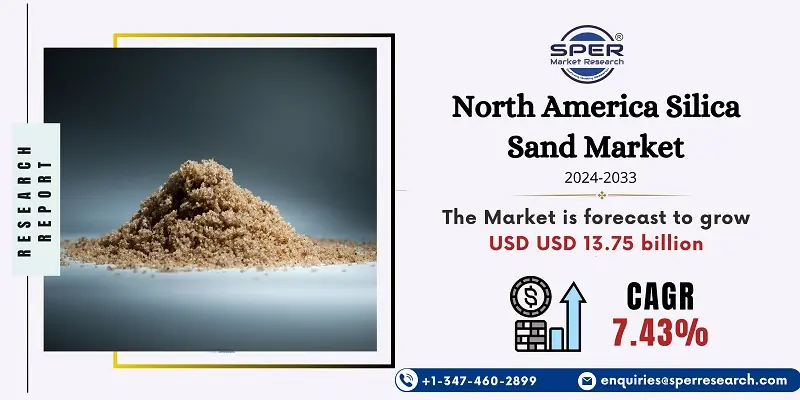
North America Silica Sand Market Growth, Size, Trends, Share, Competition and Future Outlook
North America Silica Sand Market Size- By Application, By End User- Regional Outlook, Competitive Strategies and Segment Forecast to 2033
| Published: Aug-2024 | Report ID: CHEM2484 | Pages: 1 - 158 | Formats*: |
| Category : Chemical & Materials | |||
- Strategic Alliances and Acquisitions In order to improve their market positions, major competitors in the North American silica sand market have formed alliances and made acquisitions. Expanding geographical reach, leveraging complementing expertise, and improving product portfolios are the goals of these collaborations.
- Capacities Expansion In response to the increasing demand for silica sand, a number of businesses have made plans to do so public. Infrastructure like logistics, processing plants, and additional mines are all part of these developments.
- Technological Innovations Businesses are funding R&D to create cutting-edge methods for the extraction, processing, and purification of silica sand. Reducing environmental impact, boosting operating efficiency, and enhancing product quality are the main goals of these innovations.


| Report Metric | Details |
| Market size available for years | 2020-2033 |
| Base year considered | 2023 |
| Forecast period | 2024-2033 |
| Segments covered | By Application, By End Use |
| Regions covered | Canada, Mexico, United States |
| Companies Covered | Badger Mining Corporation, Capital Sand Company, Inc, Eagle Materials, Inc, Hi-Crush, Inc, Liberty Materials, Inc, Manley Bros of Indiana, Inc, Short Mountain Silica, Source Energy Services, U.S. Silica Holdings, Inc. |
- Construction Industry
- Oil and Gas Industry
- Foundry Industry
- Chemical Industry
- Paints and Coatings
- Water Filtration
- Sports and Recreation
- Agriculture
- Industrial Applications
| By Application: |
|
| By End Use: |
|
- North America Silica Sand Market Size (FY’2024-FY’2033)
- Overview of North America Silica Sand Market
- Segmentation of North America Silica Sand Market by Application (Glass Manufacturing, Foundry, Construction, Chemicals, Oil and gas, Others)
- Segmentation of North America Silica Sand Market by End Use (Automotive, Building and construction, Packaging, Oil and gas, Others)
- Statistical Snap of North America Silica Sand Market
- Expansion Analysis of North America Silica Sand Market
- Problems and Obstacles in North America Silica Sand Market
- Competitive Landscape in the North America Silica Sand Market
- Impact of COVID-19 and Demonetization on North America Silica Sand Market
- Details on Current Investment in North America Silica Sand Market
- Competitive Analysis of North America Silica Sand Market
- Prominent Players in the North America Silica Sand Market
- SWOT Analysis of North America Silica Sand Market
- North America Silica Sand Market Future Outlook and Projections (FY’2024-FY’2033)
- Recommendations from Analyst
1.1. Scope of the report1.2. Market segment analysis
2.1. Research data source2.1.1. Secondary Data2.1.2. Primary Data2.1.3. SPER’s internal database2.1.4. Premium insight from KOL’s2.2. Market size estimation2.2.1. Top-down and Bottom-up approach2.3. Data triangulation
4.1. Driver, Restraint, Opportunity and Challenges analysis4.1.1. Drivers4.1.2. Restraints4.1.3. Opportunities4.1.4. Challenges4.2. COVID-19 Impacts of the North America Silica Sand Market.
5.1. SWOT Analysis5.1.1. Strengths5.1.2. Weaknesses5.1.3. Opportunities5.1.4. Threats5.2. PESTEL Analysis5.2.1. Political Landscape5.2.2. Economic Landscape5.2.3. Social Landscape5.2.4. Technological Landscape5.2.5. Environmental Landscape5.2.6. Legal Landscape5.3. PORTER’s Five Forces5.3.1. Bargaining power of suppliers5.3.2. Bargaining power of buyers5.3.3. Threat of Substitute5.3.4. Threat of new entrant5.3.5. Competitive rivalry5.4. Heat Map Analysis
6.1. North America Silica Sand Market Manufacturing Base Distribution, Sales Area, Product Type6.2. Mergers & Acquisitions, Partnerships, Product Launch, and Collaboration in North America Silica Sand Market.
7.1. North America Silica Sand Market Size, Share and Forecast, By Application, 2020-20267.2. North America Silica Sand Market Size, Share and Forecast, By Application, 2027-20337.3. Glass Manufacturing7.4. Foundry7.5. Construction7.6. Chemicals7.7. Oil and gas7.8. Others
8.1. North America Silica Sand Market Size, Share and Forecast, By End Use, 2020-20268.2. North America Silica Sand Market Size, Share and Forecast, By End Use, 2027-20338.3. Automotive,8.4. Building and construction8.5. Packaging8.6. Oil and gas8.7. Others
9.1. North America Silica Sand Market Size and Market Share
10.1. North America Silica Sand Market Size and Market Share By Region (2020-2026)10.2. North America Silica Sand Market Size and Market Share By Region (2027-2033)10.3. Canada10.4. Mexico10.5. United States
11.1. BADGER MINING CORPORATION11.1.1. Company details11.1.2. Financial outlook11.1.3. Product summary11.1.4. Recent developments11.2. CAPITAL SAND COMPANY, INC11.2.1. Company details11.2.2. Financial outlook11.2.3. Product summary11.2.4. Recent developments11.3. EAGLE MATERIALS, INC11.3.1. Company details11.3.2. Financial outlook11.3.3. Product summary11.3.4. Recent developments11.4. HI-CRUSH, INC11.4.1. Company details11.4.2. Financial outlook11.4.3. Product summary11.4.4. Recent developments11.5. LIBERTY MATERIALS, INC11.5.1. Company details11.5.2. Financial outlook11.5.3. Product summary11.5.4. Recent developments11.6. MANLEY BROS. OF INDIANA, INC11.6.1. Company details11.6.2. Financial outlook11.6.3. Product summary11.6.4. Recent developments11.7. SHORT MOUNTAIN SILICA11.7.1. Company details11.7.2. Financial outlook11.7.3. Product summary11.7.4. Recent developments11.8. SOURCE ENERGY SERVICES11.8.1. Company details11.8.2. Financial outlook11.8.3. Product summary11.8.4. Recent developments11.9. U.S. SILICA HOLDINGS, INC11.9.1. Company details11.9.2. Financial outlook11.9.3. Product summary11.9.4. Recent developments11.10. Others
SPER Market Research’s methodology uses great emphasis on primary research to ensure that the market intelligence insights are up to date, reliable and accurate. Primary interviews are done with players involved in each phase of a supply chain to analyze the market forecasting. The secondary research method is used to help you fully understand how the future markets and the spending patterns look likes.
The report is based on in-depth qualitative and quantitative analysis of the Product Market. The quantitative analysis involves the application of various projection and sampling techniques. The qualitative analysis involves primary interviews, surveys, and vendor briefings. The data gathered as a result of these processes are validated through experts opinion. Our research methodology entails an ideal mixture of primary and secondary initiatives.



Frequently Asked Questions About This Report
PLACE AN ORDER
Year End Discount
Sample Report
Pre-Purchase Inquiry
NEED CUSTOMIZATION?
Request CustomizationCALL OR EMAIL US
100% Secure Payment






Related Reports
Our Global Clients
Our data-driven insights have influenced the strategy of 200+ reputed companies across the globe.




















